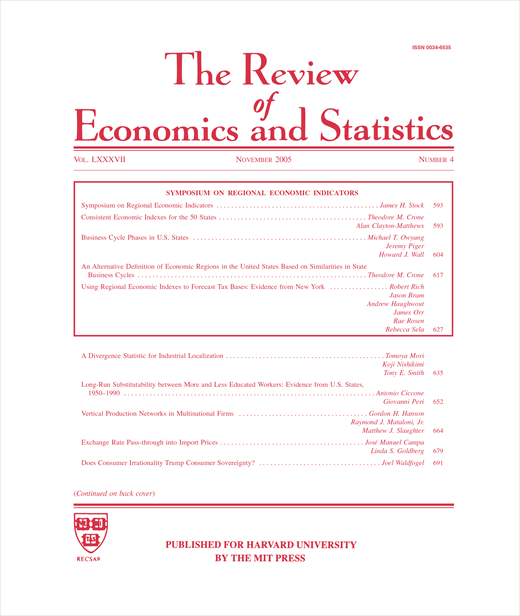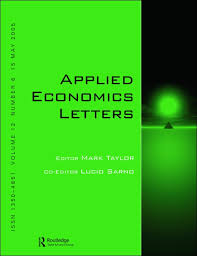
Sticky Prices or Sticky Wages? An Equivalence Result
in: Review of Economics and Statistics, forthcoming
Abstract
<p>We show an equivalence result in the standard representative agent New Keynesian model after demand, wage markup and correlated price markup and TFP shocks: assuming sticky prices and flexible wages yields identical allocations for GDP, consumption, labor, inflation and interest rates to the opposite case- flexible prices and sticky wages. This equivalence result arises if the price and wage Phillips curves' slopes are identical and generalizes to any pair of price and wage Phillips curve slopes such that their sum and product are identical. Nevertheless, the cyclical implications for profits and wages are substantially different. We discuss how the equivalence breaks when these factor-distributional implications matter for aggregate allocations, e.g. in New Keynesian models with heterogeneous agents, endogenous firm entry, and non-constant returns to scale in production. Lastly, we point to an econometric identification problem raised by our equivalence result and discuss possible solutions thereof.</p>

Transparency and Forecasting: The Impact of Conditioning Assumptions on Forecast Accuracy
in: Applied Economic Letters, forthcoming
Abstract
<p>This study investigates the impact of inaccurate assumptions on economic forecast precision. We construct a new dataset comprising an unbalanced panel of annual German GDP forecasts from various institutions, taking into account their underlying assumptions. We explicitly control for different forecast horizons to reflect the information available at the time of release. Our analysis reveals that approximately 75% of the variation in squared forecast errors can be attributed to the variation in squared errors of the initial assumptions. This finding emphasizes the importance of accurate assumptions in economic forecasting and suggests that forecasters should transparently disclose their assumptions to enhance the usefulness of their forecasts in shaping effective policy recommendations.</p>

The Effects of the Iberian Exception Mechanism on Wholesale Electricity Prices and Consumer Inflation: A Synthetic-controls Approach
in: Applied Economic Letters, forthcoming
Abstract
This study employs synthetic control methods to estimate the effect of the Iberian exception mechanism on wholesale electricity prices and consumer inflation, for both Spain and Portugal. We find that the intervention led to an average reduction of approximately 40% in the spot price of electricity between July 2022 and June 2023 in both Spain and Portugal. Regarding overall inflation, we observe notable differences between the two countries. In Spain, the intervention has an immediate effect, and results in an average decrease of 3.5 percentage points over the twelve months under consideration. In Portugal, however, the impact is small and generally close to zero. Different electricity market structures in each country are a plausible explanation.

Step by Step ‒ A Quarterly Evaluation of EU Commission's GDP Forecasts
in: Journal of Forecasting, No. 3, 2025
Abstract
<p>The European Commission’s growth forecasts play a crucial role in shaping policies and provide a benchmark for many (national) forecasters. The annual forecasts are built on quarterly estimates, which do not receive much attention and are hardly known. Therefore, this paper provides a comprehensive analysis of multi-period ahead quarterly GDP growth forecasts for the European Union (EU), euro area, and several EU member states with respect to first-release and current-release data. Forecast revisions and forecast errors are analyzed, and the results show that the forecasts are not systematically biased. However, GDP forecasts for several member states tend to be overestimated at short-time horizons. Furthermore, the final forecast revision in the current quarter is generally downward biased for almost all countries. Overall, the differences in mean forecast errors are minor when using real-time data or pseudo-real-time data and these differences do not significantly impact the overall assessment of the forecasts’ quality. Additionally, the forecast performance varies across countries, with smaller countries and Central and Eastern European countries (CEECs) experiencing larger forecast errors. The paper provides evidence that there is still potential for improvement in forecasting techniques both for nowcasts but also forecasts up to eight quarters ahead. In the latter case, the performance of the mean forecast tends to be superior for many countries.</p>

A Multi-Model Assessment of Inequality and Climate Change
in: Nature Climate Change, October 2024
Abstract
<p>Climate change and inequality are critical and interrelated defining issues for this century. Despite growing empirical evidence on the economic incidence of climate policies and impacts, mainstream model-based assessments are often silent on the interplay between climate change and economic inequality. For example, all the major model comparisons reviewed in IPCC neglect within-country inequalities. Here we fill this gap by presenting a model ensemble of eight large-scale Integrated Assessment Models belonging to different model paradigms and featuring economic heterogeneity. We study the distributional implications of Paris-aligned climate target of 1.5 degree and include different carbon revenue redistribution schemes. Moreover, we account for the economic inequalities resulting from residual and avoided climate impacts. We find that price-based climate policies without compensatory measures increase economic inequality in most countries and across models. However, revenue redistribution through equal per-capita transfers can offset this effect, leading to on average decrease in the Gini index by almost two points. When climate benefits are included, inequality is further reduced, but only in the long term. Around mid-century, the combination of dried-up carbon revenues and yet limited climate benefits leads to higher inequality under the Paris target than in the Reference scenario, indicating the need for further policy measures in the medium term.</p>



